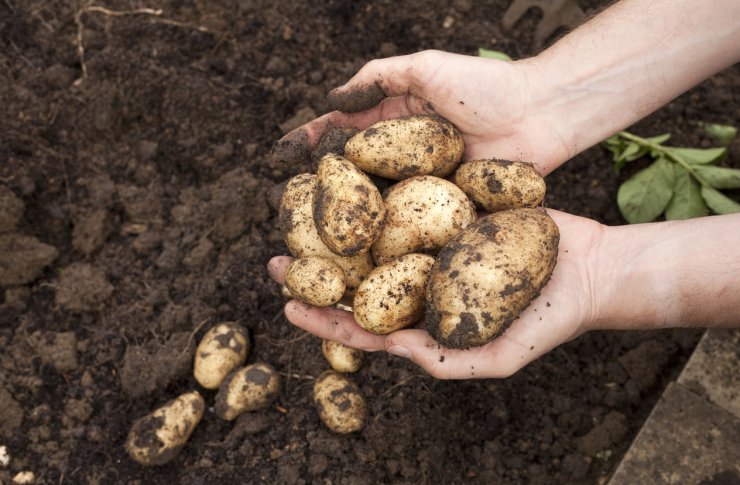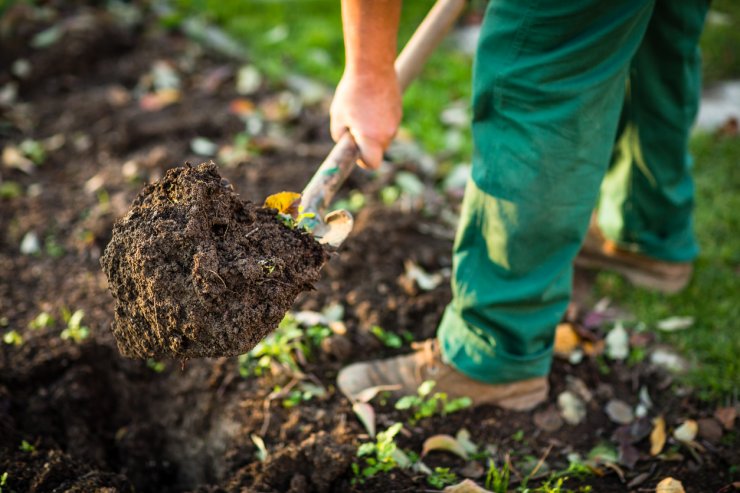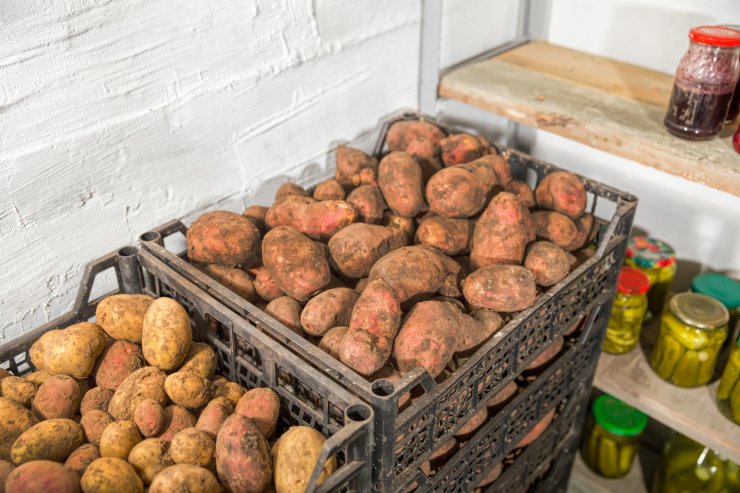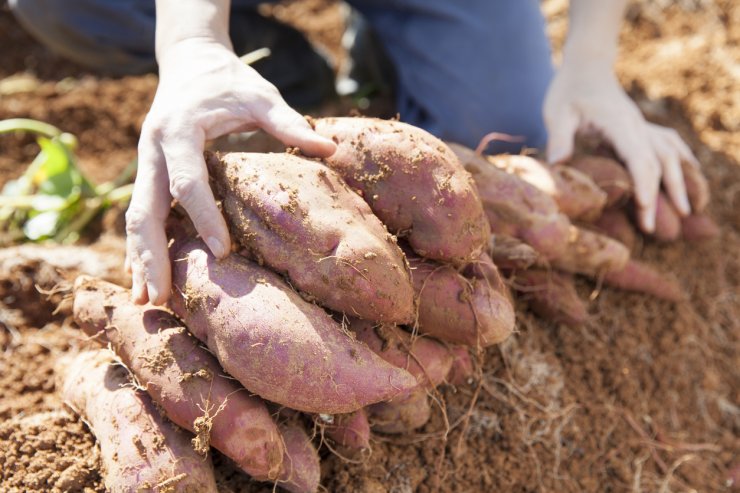
Freshly harvested potatoes.
Potato Harvesting

Lifting potatoes from soil.
Different potatoes are ready to harvest at different times. Technically, you can start harvesting some potatoes when they’re big enough to warrant the effort to dig out. These are the “new” potatoes you hear about. They’re tender and tasty—and delicate.
The tubers deepest from the surface are the ones that will mature first. If you dig carefully into your mound (you’ve been hilling all along, right?), you can harvest the largest potatoes and leave the smallest to keep on growing. These so-called new potatoes don’t store well, so only harvest what you’re going to eat within a week or two.
You can keep on doing periodic harvesting if you like; or you can leave the plant to finish growing and harvest all your potatoes when they’re mature. When’s that? When the foliage dies back.
If you know that your potatoes are due to harvest (each variety has a different maturity rate), you can cut the top growth off to give the tubers a signal that it’s time to firm up. You can leave the potatoes in the ground for two weeks after the tops have died back (or you’ve cut them off); this gives the potato’s skin time to harden, which will reduce the chance of rot when you store them.
If it’s clearly harvest time but the weather is warm and wet, dig those potatoes out right away or the tubers may start to sprout or rot.
Your late-maturing potatoes will be ready close to the first frost. The frost will kill the tops of the plant, but the potatoes will be safe underground. Leave them there for a couple weeks after the frost—but before a hard freeze. If your potatoes freeze underground, they’ll rot in storage.
Always dig carefully when you’re harvesting your potatoes. Use a spading fork to dig under the lowest layer of potatoes. Remember: potatoes are delicate. You can bruise them easily and that can open the door to rot. The warmer the soil is, the better. Once you know it’s time, don’t delay. Get out there and bring in your harvest!
Potato Curing & Storage

Potatoes in storage.
Once you’ve harvested your home-grown spuds, you need to put them into storage to cure; this is where the skin has time to set. You need a dark space with high humidity and a temperature between 50 to 60 degrees F. This could be a cooler part of your house, such as a utility room with a portable humidifier.
After their two-week curing time, the potatoes are ready to head into long-term storage (late-season varieties do best in long-term storage). Put them in burlap bags or slotted bins to allow for airflow. Store them in a dark space at a temperature of 40 degrees F. If you’re planning to eat the potatoes within a week, you can store them at room temperature.
Do not store potatoes in the fridge. Also, do not store your potatoes with fruit. Gas from the fruit makes potatoes sprout. And unless you’re cooking, keep your potatoes away from onions; the two in close proximity will make the potatoes sprout.
Sweet Potato Harvesting

Harvesting sweet potatoes.
There’s one key difference in the harvesting process for sweet potatoes: do not water sweet potatoes for the last three to four weeks before harvest. Too much water late in their growth stage can lead to rot.
Other than the watering hiatus, harvesting sweet potatoes is much the same as with potatoes. Most gardeners wait until the foliage dies back. If you have a frost, it’s definitely time to harvest. Cut the vines off the plant to prevent decay.
Use a spading fork to gently loosen the sweet potatoes from the ground. Sweet potatoes are very fragile at this point; it’s easy to bruise them. Do all you can to avoid scratching or bruising the roots as you harvest them. And don’t let them sit in the sun for more than an hour; they can get sunburn (yes, really).
Sweet Potato Curing & Storage

Sweet potatoes being cured.
Let the roots dry before you set them aside for curing. Line containers with rags or some other soft material to keep the roots from getting scratched. Curing sweet potatoes helps heal any wounds they may have, and it improves their flavor. Store them for about 10 days in a warm spot—80 to 85 degrees F and humidity of 85% to 90%. If you don’t have that kind of environment, you can cure them for two to three weeks at 65 to 75 degrees F. To keep up the humidity, store the potatoes in stacked crates and cover them with paper or heavy cloth. You can also use perforated plastic bags, which will keep the humidity high while allowing excess humidity to escape.
Once your sweet potatoes are cured, move them to a dark location where the temperature is steady at about 55 to 60 degrees F. One good storage method is to wrap them in newspaper and store them in a cool closet. When sweet potatoes are cured properly, you can store them for three to four months.
Do not store sweet potatoes in the fridge. The cold can injure them.
How do you bring in your potato or sweet potato harvest? Do you have any great tips about curing and storing your harvest? Please tell us how you deal with harvesting in your garden.


 Previous
Previous


I grew purple potatoes.. the plants are stating to have flowers..!is that a time to harvest?
Ellen,
Depending on the variety of purple potato you’ve chosen, they could reach full maturity in as little as 70 days or as much as 120 days. However, you can start harvesting “new potatoes” as soon as your plants are done flowering. This is perfect if you want to enjoy some now and save others for later in the season.
Keep in mind that these young potatoes will have very thin skin and therefore won’t store well long term like a mature potato will. So plan to eat your early harvested potatoes as soon as possible.
Enjoy and Happy Gardening!